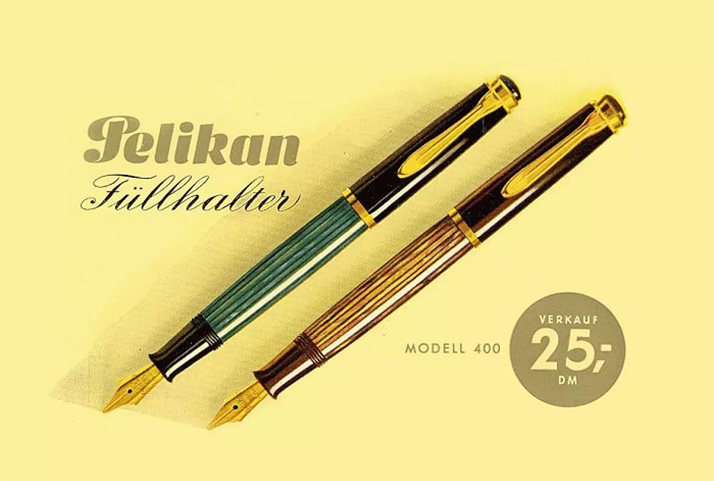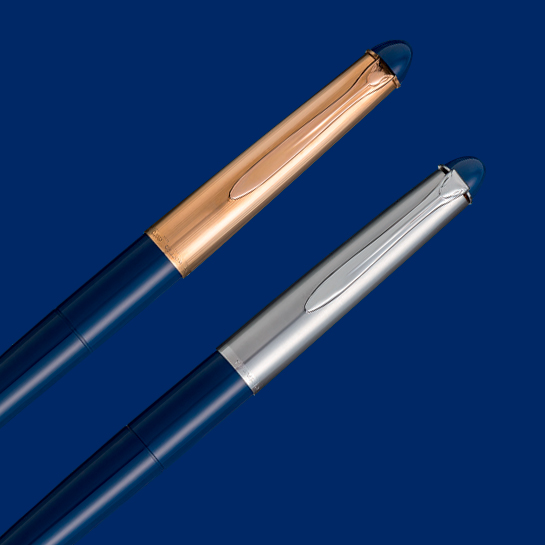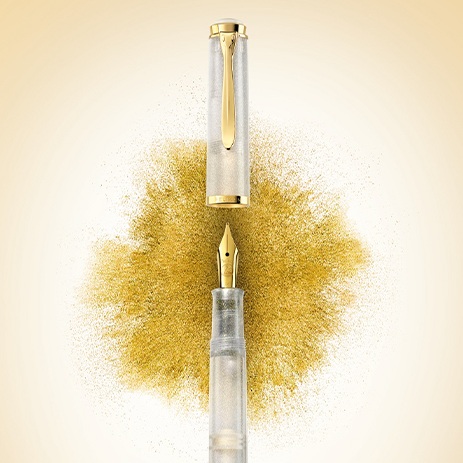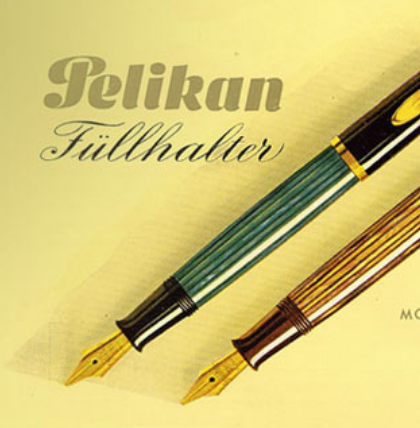
1950-1982 The “Striped” Pelikan Fountain Pen
Based on the increased distribution of the fountain pen after World War II, the use of iron gall nut ink decreased, as it is blue when still liquid, however, turns black when dry, due to oxidation. Instead, the interest in colored inks grew and, in time, the color royal blue prevailed. The ink is brightly colored. The surface tension is made to provide an easy but not too strong ink flow, and it also provides quick drying on the paper, however, not on the nib.Even after not using the fountain for a while, no residues form.

In 1950, after several years of development, the Pelikan fountain pen 400 was launched. The remarkable green striped ink container became a color symbol for the Pelikan fountain pen, which has yet remained.
The same counts for the beak shaped clip that had already been “invented” during war. Some variations were designed with brownish tortoiseshell transparent or black transparent striped ink containers. The models of the 500 series have a cap made of rolled gold and a matching sleeve over the gripping section. These previously named parts even have a 14-carat gold plating on the model 600.
In 1952, the model 140 was launched. Like the Rappen hedged the model 100 downwards in price in 1932, the fountain pen 140 that cost DM 16.50 safeguarded the pen 400, which was priced at DM 25,-. This fountain pen was delivered in black, blue, red, green, and gray. In 1954, the transparent green-striped barrel followed, and the price lowered to DM 15,-. In 1955, Pelikan counted among one of the last manufacturers of writing instruments and, moving with the times, Pelikan introduced ballpoint pens fitting the fountain pens. Pelikan called the pen “Roller”. The writing instrument that is known today as a rollerball pen was not added to the Pelikan product range until the 1970s.
It was the year 1956 when the models 400 and 500 switched over to 400NN and 500NN. Like its predecessor, the 400NN cost DM 25,- and was the leading model of its kind on the market.


The year 1958 began with the introduction of the model series P1 and with it began a new era in the construction of Pelikan fountain pens. The fountain pens had a completely covered nib and a thermal ink feed that was able to improve the blotting problem by far. The piston-filling mechanism remained at first.
In 1960, the Pelikano was launched – it was the first school fountain pen that was constructed based on fundamental research from writing educators, teachers, and students. The advantages, its thermal ink feed, the cartridge filling system, its low weight, the unbreakable aluminum cap, and its color combination blue and silver; combined with the advertisement in television made this pen the leading fountain pen in the market.
Inspired by the great success of the Pelikano pen, Pelikan launched the models P15 and P25 for adults. Even though they had the same shape as the Pelikano, the difference was that they were equipped with a golden nib. In the following years, changes were made on the nib and the shape of the Pelikano fountain pen, due to the new requirements given by the teachers. The models for adults received the same modifications, however, were alternatively offered with a piston filling mechanism. With these models, however, Pelikan never managed to keep the position in the market it had reached with the model 400, of which manufacturing was ceased in 1956.



